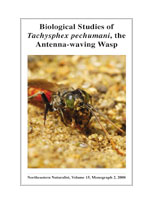A re-examination of the nesting behavior of T. pechumani from 1991 to 1999 at 43 sites in the central Great Lakes Region and southern New Jersey revealed little difference between the two groups. More than 200 females were observed nesting solitarily in June–July in sandy soils of mostly oak/pine-dominant barrens, savanna, and open woodland. Tachysphex pechumani was univoltine, with a flight period encompassing mainly late spring–early summer. Emergence and senescence of wasps occurred earlier in the southern and later in the northern parts of the species' range. Males were not territorial and dug resting burrows for the night and to avoid the hot sand and inclement weather. Nesting aggregations ranged from a few to 48 females at a site. Distinct bimodality in nesting occurred on hot days, with peak activity in late morning and a secondary rise in activity in mid- to late afternoon. Wasps demonstrated genus-atypical burrow excavation and tumulus formation. Rather slow and jerky movements characterized female behavior. There was little variation among females in burrow excavation, orientation, hunting, prey capture, prey transport, and final closure. Geographic variation included longer burrows and deeper cells at many southerly locations. Females preyed mostly on nymphal Melanoplinae and Gomphocerinae (Acrididae), primarily Melanoplus species. Some Melanoplus species were captured earlier in the season than Gomphocerinae in synchrony with their earlier emergence and growth schedules. Wasps faced and circled prey while waving antenna before pouncing on and stinging the grasshopper. The relatively large prey was often transported to the nest slowly and haltingly. Random positioning of paralyzed grasshoppers near entrances constituted genus-atypical behavior. A single paralyzed prey was placed commonly head inward and ventral side upward in the one-celled nest. The wasp's egg was laid transversely across the grasshopper's pro- and mesosternum. Some females completed two nests per day under favorable weather conditions. Sarcophagid flies of the tribe Miltogrammini (Sphixapata rubriventris, S. vigilans, S. trilineata, Sphenometopa tergata, Taxigramma heteroneura) were major enemies of this wasp.
BioOne.org will be down briefly for maintenance on 17 December 2024 between 18:00-22:00 Pacific Time US. We apologize for any inconvenience.
How to translate text using browser tools
1 March 2008
II. Nesting Behavior of Tachysphex pechumani (Hymenoptera: Crabronidae)
Frank E. Kurczewski
ACCESS THE FULL ARTICLE

Northeastern Naturalist
Vol. 15 • No. sp5
March 2008
Vol. 15 • No. sp5
March 2008




